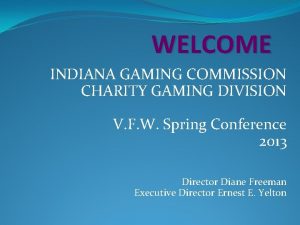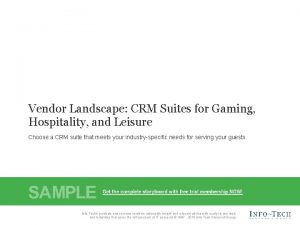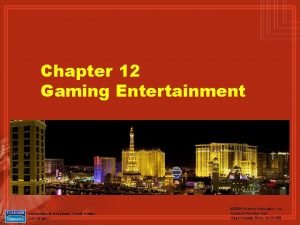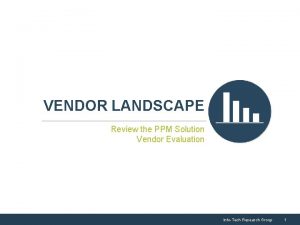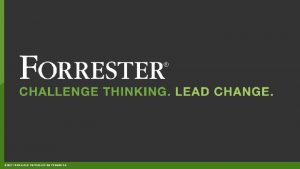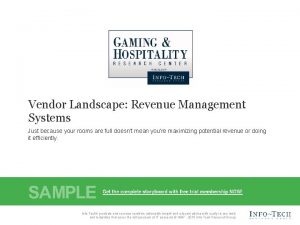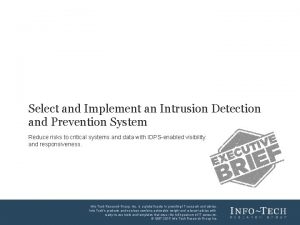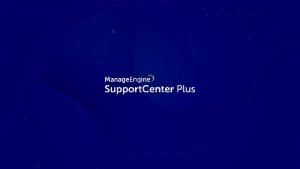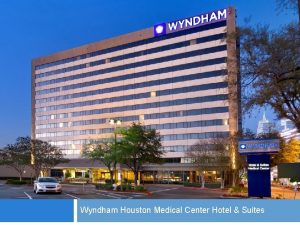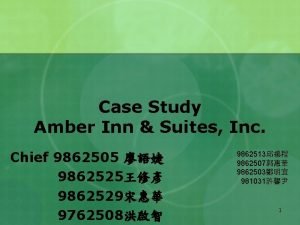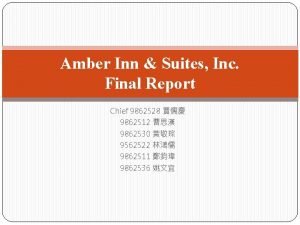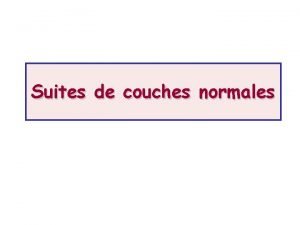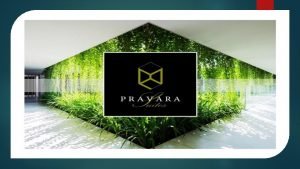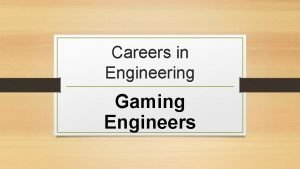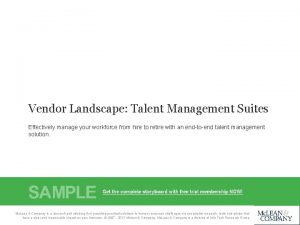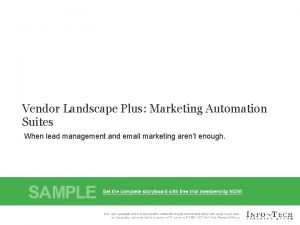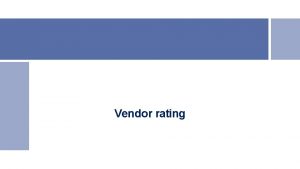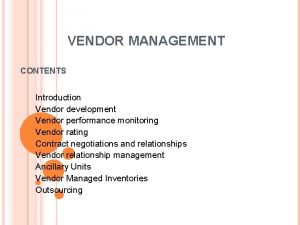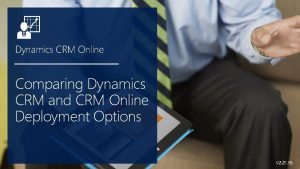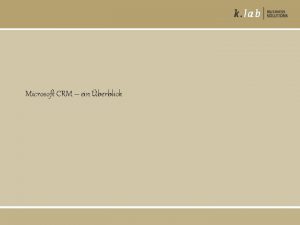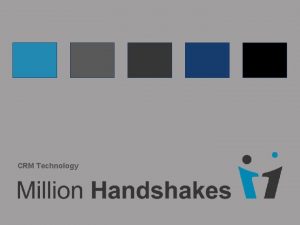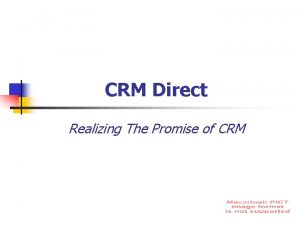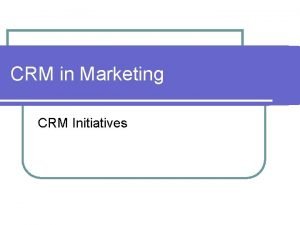Vendor Landscape CRM Suites for Gaming Hospitality and












- Slides: 12

Vendor Landscape: CRM Suites for Gaming, Hospitality, and Leisure Choose a CRM suite that meets your industry-specific needs for serving your guests. Vendor Landscape: GHRC CRM Info-Tech Research Group, Inc. Is a global leader in providing IT research and advice. Info-Tech’s products and services combine actionable insight and relevant advice with Info-Tech's products and services combine actionable insight advice ready-to-use tools and templates that cover theand fullrelevant spectrum of IT with concerns. and templates that cover the full spectrum©of 1997 -2015 IT concerns. © 1997 -Research 2015 Info-Tech Group Research Inc. Info-Tech Research Group 1

Introduction Having a well-oiled customer relationship management (CRM) platform in place is critical for organizations in the gaming, hospitality, and leisure industries in order to build profitable patron relationships and experiences. Pick a best-of-breed GHRC CRM vendor with the product and vendor credentials to meet your needs. This Research Is Designed For: This Research Will Help You: üEnterprises seeking to select a solution for CRM üUnderstand what’s new in the CRM market. in the gaming, leisure, and hospitality area. üTheir CRM use case may include: • Patron management & VIP treatment. • Customer analytics. üEvaluate CRM vendors and products for your enterprise needs. üDetermine which products are most appropriate for particular use cases and scenarios. • Extensive integrations. • 360 degree view of guests for deeper loyalty & personalized experiences. • Optimized host productivity. Vendor Landscape: GHRC CRM Info-Tech Research Group 2

GHRC CRM Market Overview How it got here Where it’s going • The CRM market began in the 1980 s with software designed for automating customer interactions in the call center and basic contact management software. In the 1990 s, these products matured with Sales Force Automation (SFA) tools. • Many CRM vendors – including those that specialize in GHRC use cases – are incorporating additional mobile access and analytics capabilities into their solutions. Cutting edge mobile technologies include browserindependent and tablet-optimized applications, as well as dedicated apps that leverage native device capabilities. Usability is expected to remain a differentiator for CRM vendors. • During the late 1990 s and mid-2000 s, integrated CRM suites with comprehensive feature sets were extremely popular with a variety of enterprises. In the latter half of the 2000 s, organizations put new emphasis on a common suite with services that could be added. Software-as-a-Service (Saa. S) became the dominant deployment method. • As the CRM market matured, a standalone market for CRM products that incorporated (or integrated) hospitality, leisure, and gaming feature sets emerged. These products focused on end-to-end guest or client experiences and often sought to integrate with property management and gaming systems. • Customer analytics, including data gleaned analyzed from social media channels, has been an increasing focus area for many hospitality-centric insights. Vendors are providing capabilities that move beyond the transaction approach to guest management and instead allow for the creation of deep insights. • Info-Tech predicts that CRM players will continue to develop robust social capabilities or acquire standalone social management vendors to level the playing field. As the market evolves, capabilities that were once cutting edge become default and new functionality becomes differentiating. For example, account management is becoming a table-stakes capability. Focus on the different components of sales, marketing, and guest service management features to get the best fit for your requirements. Vendor Landscape: GHRC CRM Info-Tech Research Group 3

CRM vendor selection / knock-out criteria: market share, mind share, and platform coverage • For enterprise scale needs, we looked at the most powerful incumbent CRM vendors and evaluated their readiness for gaming, hospitality, and leisure specific use cases. We also included two best-of-breed vendors purely focused on the use cases of our GHRC clients. • Included For this Vendor in this Vendor. Landscape, Landscape: Info-Tech focused on those vendors that offer • • • broad capabilities across platforms and that a strong Cendyn/ONE. A hospitality-focused CRMmultiple vendor with rich analytics built on top of thehave IBM Cognos platform. market presence and/or reputational presence among mid- and large-sized Guestware. A vendor offering a full suite of hospitality-centric products, with an emphasis on guest management. enterprises. Infor. A vendor popular in the gaming & hospitality market, offering a full-suite of market-centric products. • Microsoft. Dynamics remains a heavyweight solution and Microsoft positions it well via hospitality-specific channels. • Oracle. Siebel remains a popular vendor for organizations entrenched in the Oracle ecosystem. • Salesforce. A Saa. S powerhouse with a very compelling offering for gaming, leisure, and hospitality use cases. • Sugar. CRM. A vendor popular with mid-market clients that have unique GHRC-centric needs. Vendor Landscape: GHRC CRM Info-Tech Research Group 4

CRM GHRC criteria & weighting factors Criteria Weighting Product Evaluation Criteria Features The solution provides basic and advanced feature/functionality. Usability The end-user and administrative interfaces are intuitive and offer streamlined workflow. Affordability Implementing and operating the solution is affordable given the technology. Architecture Multiple deployment options and extensive integration capabilities are available. Usability 25% Features 50% 10% Affordability 15% Architecture Product 50% Vendor Evaluation Criteria Viability Strategy Reach Channel Vendor is profitable, knowledgeable, and will be around for the long term. 50% Vendor is committed to the space and has a future product and portfolio roadmap. Vendor offers global coverage and is able to sell and provide post-sales support. Viability 15% 30% Vendor channel strategy is appropriate and the channels themselves are strong. 30% Channel Vendor Landscape: GHRC CRM Strategy Reach 25% Info-Tech Research Group 5

Table Stakes represent the minimum standard; without these, a product doesn’t even get reviewed The Table Stakes Feature What it is: Contact Repository Platform must be able to store and track guest or contact record details. Guest Tracking Solution must be able to track a guest through the duration of their stay on a property. Experience Management Solution must have some form of guest experience tracking and management tools. Mobile Access Platform must have either native mobile apps or be accessible via mobile browser. What does this mean? The products assessed in this Vendor Landscape. TM meet, at the very least, the requirements outlined as Table Stakes. Many of the vendors go above and beyond the outlined Table Stakes, some even do so in multiple categories. This section aims to highlight the products’ capabilities in excess of the criteria listed here. If Table Stakes are all you need from your GHRC solution, the only true differentiator for the organization is price. Otherwise, dig deeper to find the best price to value for your needs. Vendor Landscape: GHRC CRM Info-Tech Research Group 6

Advanced Features are the capabilities that allow for granular market differentiation Scoring Methodology Info-Tech scored each vendor’s features offering as a summation of its individual scores across the listed advanced features. Vendors were given one point for each feature the product inherently provided. Some categories were scored on a more granular scale with vendors receiving half points. Advanced Features Feature What we looked for: Contact Record Management How customer records are stored and structured in the system; the depth and breadth of fields in the contact management module of the platform. Full Guest Management End-to-end capabilities for tracking and managing guests during the duration of their stay (as well as before and after their stay). Loyalty/Reward Management Functionality for the set-up, administration, execution, and tracking of hospitality, leisure, and gaming reward/loyalty systems. Sales Automation Capabilities for setting up workflows for lead intake, management, and prioritization within a leisure, hospitality, and gaming context. Marketing Automation Capabilities for setting up marketing, advertising, and promotion workflows. Basic digital content and asset management for marketing campaigns. i. Gaming Integration with a wide breadth and depth of i. Gaming and/or casino software suites. Customer Analytics Robust analytics capabilities and dashboards for providing insights about guests and customers, including social analytics. For an explanation of how Advanced Features are determined, see Information Presentation – Feature Ranks (Stoplights) in the Appendix. Vendor Landscape: GHRC CRM Info-Tech Research Group 7

Appendix 1. Vendor Landscape Methodology: Overview 2. Vendor Landscape Methodology: Product Selection & Information Gathering 3. Vendor Landscape Methodology: Scoring 4. Vendor Landscape Methodology: Information Presentation 5. Vendor Landscape Methodology: Fact Check & Publication 6. Product Pricing Scenario Vendor Landscape: GHRC CRM Info-Tech Research Group 8

Vendor Landscape Methodology: Overview Info-Tech’s Vendor Landscapes are research materials that review a particular IT market space, evaluating the strengths and abilities of both the products available in that space, as well as the vendors of those products. These materials are created by a team of dedicated analysts operating under the direction of a senior subject matter expert over a period of six weeks. Evaluations weigh selected vendors and their products (collectively “solutions”) on the following eight criteria to determine overall standing: • Features: The presence of advanced and market-differentiating capabilities. • Usability: The intuitiveness, power, and integrated nature of administrative consoles and client software components. • Affordability: The three-year total cost of ownership of the solution. • Architecture: The degree of integration with the vendor’s other tools, flexibility of deployment, and breadth of platform applicability. • Viability: The stability of the company as measured by its history in the market, the size of its client base, and its financial performance. • Strategy: The commitment to both the market-space, as well as to the various sized clients (small, mid-sized, and enterprise clients). • Reach: The ability of the vendor to support its products on a global scale. • Channel: The measure of the size of the vendor’s channel partner program, as well as any channel strengthening strategies. Evaluated solutions are plotted on a standard two by two matrix: • Champions: Both the product and the vendor receive scores that are above the average score for the evaluated group. • Innovators: The product receives a score that is above the average score for the evaluated group, but the vendor receives a score that is below the average score for the evaluated group. • Market Pillars: The product receives a score that is below the average score for the evaluated group, but the vendor receives a score that is above the average score for the evaluated group. • Emerging Players: Both the product and the vendor receive scores that are below the average score for the evaluated group. Info-Tech’s Vendor Landscapes are researched and produced according to a strictly adhered to process that includes the following steps: • Vendor/product selection • Information gathering • Vendor/product scoring • Information presentation • Fact checking • Publication This document outlines how each of these steps is conducted. Vendor Landscape: GHRC CRM Info-Tech Research Group 9

Vendor Landscape Methodology: Vendor/Product Selection & Information Gathering Info-Tech works closely with its client base to solicit guidance in terms of understanding the vendors with whom clients wish to work and the products that they wish evaluated; this demand pool forms the basis of the vendor selection process for Vendor Landscapes. Balancing this demand, Info-Tech also relies upon the deep subject matter expertise and market awareness of its Senior, Lead, and Principle Research Analysts to ensure that appropriate solutions are included in the evaluation. As an aspect of that expertise and awareness, Info-Tech’s analysts may, at their discretion, determine the specific capabilities that are required of the products under evaluation, and include in the Vendor Landscape only those solutions that meet all specified requirements. Information on vendors and products is gathered in a number of ways via a number of channels. Initially, a request package is submitted to vendors to solicit information on a broad range of topics. The request package includes: • A detailed survey. • A pricing scenario (see Vendor Landscape Methodology: Price Evaluation and Pricing Scenario, below). • A request for reference clients. • A request for a briefing and, where applicable, guided product demonstration. These request packages are distributed approximately twelve weeks prior to the initiation of the actual research project to allow vendors ample time to consolidate the required information and schedule appropriate resources. During the course of the research project, briefings and demonstrations are scheduled (generally for one hour each session, though more time is scheduled as required) to allow the analyst team to discuss the information provided in the survey, validate vendor claims, and gain direct exposure to the evaluated products. Additionally, an end-user survey is circulated to Info-Tech’s client base and vendor-supplied reference accounts are interviewed to solicit their feedback on their experiences with the evaluated solutions and with the vendors of those solutions. These materials are supplemented by a thorough review of all product briefs, technical manuals, and publicly available marketing materials about the product, as well as about the vendor itself. Refusal by a vendor to supply completed surveys or submit to participation in briefings and demonstrations does not eliminate a vendor from inclusion in the evaluation. Where analyst and client input has determined that a vendor belongs in a particular evaluation, it will be evaluated as best as possible based on publicly available materials only. As these materials are not as comprehensive as a survey, briefing, and demonstration, the possibility exists that the evaluation may not be as thorough or accurate. Since Info-Tech includes vendors regardless of vendor participation, it is always in the vendor’s best interest to participate fully. All information is recorded and catalogued, as required, to facilitate scoring and for future reference. Vendor Landscape: GHRC CRM Info-Tech Research Group 10

Vendor Landscape Methodology: Scoring Once all information has been gathered and evaluated for all vendors and products, the analyst team moves to scoring. All scoring is performed at the same time so as to ensure as much consistency as possible. Each criterion is scored on a ten point scale, though the manner of scoring for criteria differs slightly: • Features is scored via Cumulative Scoring • Affordability is scored via Scalar Scoring • All other criteria are scored via Base 5 Scoring In Cumulative Scoring, a single point is assigned to each evaluated feature that is regarded as being fully present, partial points to each feature that is partially present, and zero points to features that are deemed to be absent or unsatisfactory. The assigned points are summed and normalized to a value out of ten. For example, if a particular Vendor Landscape evaluates eight specific features in the Feature Criteria, the summed score out of eight for each evaluated product would be multiplied by 1. 25 to yield a value out of ten. In Scalar Scoring, a score of ten is assigned to the lowest cost solution, and a score of one is assigned to the highest cost solution. All other solutions are assigned a mathematically determined score based on their proximity to / distance from these two endpoints. For example, in an evaluation of three solutions, where the middle cost solution is closer to the low end of the pricing scale it will receive a higher score, and where it is closer to the high end of the pricing scale it will receive a lower score; depending on proximity to the high or low price it is entirely possible that it could receive either ten points (if it is very close to the lowest price) or one point (if it is very close to the highest price). Where pricing cannot be determined (vendor does not supply price and public sources do not exist), a score of 0 is automatically assigned. In Base 5 scoring a number of sub-criteria are specified for each criterion (for example, Longevity, Market Presence, and Financials are subcriteria of the Viability criterion), and each one is scored on the following scale: 5 - The product/vendor is exemplary in this area (nothing could be done to improve the status). 4 - The product/vendor is good in this area (small changes could be made that would move things to the next level). 3 - The product/vendor is adequate in this area (small changes would make it good, more significant changes required to be exemplary). 2 - The product/vendor is poor in this area (this is a notable weakness and significant work is required). 1 - The product/vendor is terrible/fails in this area (this is a glaring oversight and a serious impediment to adoption). The assigned points are summed and normalized to a value out of ten as explained in Cumulative Scoring above. Scores out of ten, known as Raw scores, are transposed as-is into Info-Tech’s Vendor Landscape Shortlist Tool, which automatically determines Vendor Landscape positioning (see Vendor Landscape Methodology: Information Presentation - Vendor Landscape, below), Criteria Score (see Vendor Landscape Methodology: Information Presentation - Criteria Score, below), and Value Index (see Vendor Landscape Methodology: Information Presentation - Value Index, below). Vendor Landscape: GHRC CRM Info-Tech Research Group 11

Info-Tech Research Group Helps IT Professionals To: ü ü ü Quickly get up to speed with new technologies ü Manage business expectations ü Justify IT spending and prove the value of IT ü Train IT staff and effectively manage an IT department Make the right technology purchasing decisions – fast Deliver critical IT projects, on time and within budget Sign up for free trial membership to get practical solutions for your IT challenges “Info-Tech helps me to be proactive instead of reactive – a cardinal rule in a stable and leading edge IT environment. • - ARCS Commercial Mortgage Co. , LP Toll Free: 1 -888 -670 -8889 Vendor Landscape: GHRC CRM www. infotech. com Info-Tech Research Group 12
 Indiana gaming commission charity gaming division
Indiana gaming commission charity gaming division Crm suites
Crm suites What defines a gaming entertainment business
What defines a gaming entertainment business Vendor landscape meaning
Vendor landscape meaning Content marketing platforms forrester
Content marketing platforms forrester Voice of the customer vendor landscape
Voice of the customer vendor landscape Idp vendor landscape
Idp vendor landscape Zoho
Zoho Wyndham texas medical center
Wyndham texas medical center Amber inn and suites
Amber inn and suites Ambers inn and suites
Ambers inn and suites Suites de couches normales
Suites de couches normales Prava suites
Prava suites
